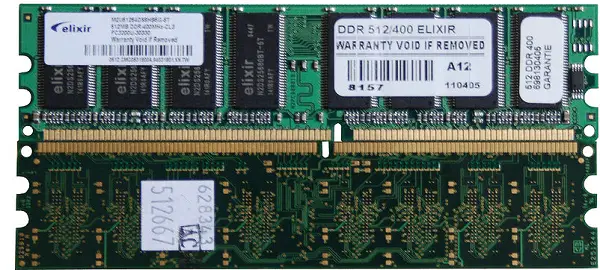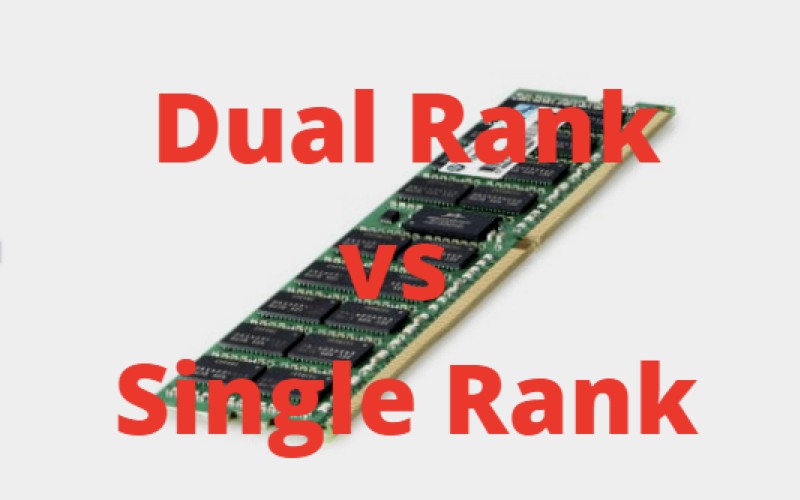As a computer user, you may be wondering what the difference is between dual rank and single rank memory. Both are types of Random Access Memory (RAM), but there are some key differences between the two.
In this article, we’ll explore those differences so that you can make an informed decision about which type of RAM is right for your needs.
What Are Memory Ranks?
Memory ranks refer to the number of independent data channels within a DIMM, with each channel consisting of one or more DRAM chips. The term “rank” is generally used to describe DRAM chips connected to the same data channel, with each rank of DRAM chips being controlled by a separate chip select.
A rank of DRAM chips is also sometimes referred to as a “bank” of DRAM chips.

One or more DRAM chips can be placed on a single data rank. For example, a rank could consist of four 1Gbit DRAM chips, resulting in a total capacity of 4GB. Or, a rank could consist of eight 512Mbit DRAM chips, resulting in a total capacity of 4GB for that rank.
The higher the capacity of the DRAM chips on a given rank, the lower the number of DRAM chips on that rank.
The number of ranks present on a DIMM can vary but is typically one, two, or four. A single-rank DIMM has all of its DRAM chips on a single rank, while a dual-rank DIMM has its DRAM chips arranged in two ranks (with each rank consisting of some DRAM chips).
A quad-rank DIMM similarly has its DRAM chips arranged in four ranks.
The capacity of a DIMM is generally equal to the number of ranks present multiplied by the capacity of each rank. For example, a single-rank DIMM with eight 512Mbit DRAM chips would have a total capacity of 4GB, while a dual-rank DIMM with the same DRAM chips would have a total capacity of 8GB.

The number of ranks present on a DIMM can have an effect on both performance and stability.
In general, having more ranks present on a DIMM can improve performance by allowing the DIMM to utilize more data channels.
However, adding additional ranks can also increase the likelihood of stability issues, as the DIMM becomes more complex and thus more difficult to manage.
As a result, it is generally recommended that users only utilize as many ranks as necessary to meet their capacity needs. For most users, a single-rank or dual-rank DIMM will suffice. Only users who require a very high-capacity DIMM (8GB or higher) should consider a quad-rank DIMM.
What Is Dual Rank RAM?
Dual rank RAM is a type of computer memory made up of two ranks of memory chips. The first rank contains the most frequently accessed data, while the second rank contains the less frequently accessed data.
This type of memory is often used in servers and high-end gaming computers, as it provides a higher level of performance than single-rank RAM.

Dual rank RAM is typically more expensive than single rank RAM, as it requires more memory chips to operate. However, the increased performance is often worth the extra cost for those who need it.
What are the Benefits of Dual Rank RAM?
Dual rank RAM provides a number of benefits over single rank RAM, including:
- Improved Performance: Dual rank RAM can access data more quickly than single rank RAM, as the data is spread out over two ranks of memory chips. This can provide a significant boost in performance, especially in applications that require large amounts of data to be accessed quickly.
- Higher Capacity: Dual rank RAM can offer twice the capacity of single rank RAM, as it effectively doubles the number of memory chips that can be used. This can be useful in applications where large amounts of data need to be stored, such as video editing or working with large databases.

- Improved Reliability: Dual rank RAM is typically more reliable than single rank, especially when operating in demanding conditions such as high temperatures. This can be important for some applications, like servers or scientific computing.
- Faster Transfer Rates: Dual rank RAM can offer faster data transfer rates than single rank RAM, as two ranks of memory chips can be accessed simultaneously. This can be beneficial for applications that require large amounts of data to be processed quickly, such as video editing or 3D rendering.
- Improved Latency: Dual rank RAM can offer improved latency over single rank RAM, as the data is spread out over two ranks of memory chips. This can be essential for some applications, like gaming or virtual reality, where every millisecond can make a difference.
What Is Single Rank RAM?
Single rank RAM is a type of computer memory that is designed to work with a single memory channel. This means that it can only be used with one type of computer memory controller. Single rank RAM is often used in systems that only require a small amount of memory, such as laptops and netbooks.
It is also sometimes used in servers and high-end gaming PCs.

Single-rank RAM typically has a lower latency than multi-rank RAM, which means it can be faster at retrieving data. However, it is also more expensive than multi-rank RAM.
Difference Between Dual Rank and Single Rank
When you are shopping for memory, you will often see the terms “dual rank” and “single rank” used to describe the modules. While both terms are technically accurate, they can be a bit confusing if you don’t know what they mean.
In short, dual-rank memory modules have twice the number of ranks as single-rank modules.
The term “rank” refers to the number of independent banks of memory on a module. So, a dual-rank module has two independent banks of memory, while a single rank module has only one.
While you may wondering which one of the memory to pick, you need to know the differences before you make your choice.
The following are the differences:
1. Cost
The cost is one of the major differences between dual rank and single rank modules. In general, dual-rank modules are more expensive than single-rank modules. This is because they offer better performance and are more reliable.
2. Capacity
Dual rank modules typically have twice the capacity of single rank modules. This means that you can store more data on a dual-rank module than you can on a single-rank module.
3. Performance
Dual rank modules offer better performance than single rank modules. This is because they have twice the number of ranks, which gives them more bandwidth. The performance difference is most noticeable in applications that require high bandwidth, such as gaming or video editing.
4. Reliability
Dual rank modules are also more reliable than single rank modules. The reliability of a dual-rank module is about 30% higher than that of a single-rank module. This is because there are twice as many independent memory chips in a dual-rank module than in a single-rank module.
This means that if one of the memory chips in a dual-rank module fails, the other chips can still operate normally.
5. Compatibility
Dual rank modules are more compatible with newer systems than single rank modules. This is due to the fact that single-rank modules are more likely to be limited by the number of available memory channels.
Dual rank modules offer increased capacity and bandwidth, which can be especially helpful when dealing with data-intensive tasks.

6. Latency
Latency is the time it takes for the data to be accessed from the memory module. Dual rank modules have lower latency than single rank modules. This means that they can access the data faster.
7. Power Consumption
Dual rank modules consume more power than single rank modules. This is because two ranks are active at any given time, and therefore both the module and the memory controller have to work harder.
Power consumption is one of the key factors to consider when purchasing memory modules.
Dual Rank vs Single Rank: Which is Better?
If you are stuck on which type of RAM to buy for your computer, you may be wondering if there is a difference between dual rank and single rank memory. The truth is, there is a difference between the two types of RAM.
Here is a breakdown of the two types of memory so that you can decide which one is right for your needs.

- Dual rank memory is made up of two 64-bit words that are combined to form a single 128-bit word. This type of memory is typically faster than single-rank memory because it can access two words at the same time. Dual rank memory is also more expensive than single rank memory.
- Single rank memory is made up of only one 64-bit word. This type of memory is slower than dual-rank memory because it can only access one word at a time. Single rank memory is less expensive than dual rank memory.

So, which type of memory is right for you?
If you need the fastest possible RAM for your computer, you should opt for dual-rank memory. If you are on a budget, then you should opt for single-rank memory.
Frequently Asked Questions
Is Dual Rank Memory Faster?
No, dual-rank memory is not faster. In fact, it is typically slower than single-rank memory. It is, however, more stable and is often used in high-performance computers where stability is more important than speed.
What Is the Difference Between ECC and Non-ECC Memory?
ECC memory is error correction code memory. This memory is often used in servers and other mission-critical computers because it is more reliable than non-ECC memory. Non-ECC memory does not have an error correction code and is, therefore, less reliable.
What Is the Difference Between DDR3 and DDR4 Memory?
DDR3 memory is older and slower than DDR4 memory. DDR3 has a lower maximum speed and is not as efficient as DDR4. It is also not compatible with newer devices that use DDR4. If you are looking for a new memory upgrade, DDR4 is the way to go.
Why is Dual Rank Memory More Expensive?
Dual rank memory is more expensive because it uses more chips. To double the capacity, you need to double the number of chips. This also means that you will need to use more power and generate more heat. In addition, Dual rank memory is more difficult to manufacture, so the yield is lower.
This means that there will be fewer working chips per wafer, and the price will be higher.
One final reason that Dual rank memory is more expensive is that it offers higher performance. When you have more chips, you can achieve higher data transfer rates. This is why gamers and other power users are willing to pay more for Dual rank memory.
Is Quad-Rank Faster Than Dual Rank?
Yes, quad-rank is faster than dual rank. Quad-rank modules offer increased capacity and bandwidth over dual-rank modules, making them ideal for applications that require high levels of performance.
Quad-rank modules are also more expensive than dual-rank modules, so they may not be the best choice for every application.
How Do I Know If My RAM Is Single Rank?
There are a few ways to tell if your RAM is a single rank. One way is to look at the technical specifications for your specific RAM module. Another way is to inspect the RAM module itself visually.
Single rank RAM modules have only one row of chips on the front and back of the module. Dual rank RAM modules have two rows of chips on the front and back of the module.
If you’re unsure which type of RAM you have, you can always contact the manufacturer of your RAM module for more information.
Can I Use 4 Dual Rank RAM?
You can, but it will run in single-channel mode. Dual rank RAM is generally faster than single rank RAM, so it’s not ideal for gaming or other performance-sensitive applications. However, it can be a good idea for general use or for people who don’t need the absolute best performance.
Should I Buy Single Or Dual Rank RAM?
The most important factor to consider when determining whether to buy single or dual-rank RAM is the amount of available space on the motherboard. If you have a lot of space, then dual-rank RAM may be the better option. However, if you are running low on space, then single-rank RAM may be the better option.
Another factor to consider is the price of the RAM. Dual rank RAM is typically more expensive than single rank RAM, so if you are on a budget, single rank RAM may be the better option.
Ultimately, the decision of whether to buy single or dual-rank RAM depends on your specific needs and circumstances.
Can I Use Two Single Rank RAM?
You can use two single-rank RAM, but it is recommended to use two dual-rank RAM for the best performance. If you use two single-rank RAM, you will need to enable the interleaving feature in your BIOS to increase performance.
Conclusion
Getting a RAM that is of the same capacity but of different ranks doesn’t significantly impact performance. However, if you choose between single and dual-rank RAM, go for the dual-rank one. It is slightly faster than the single rank RAM and offers better overclocking potential.






